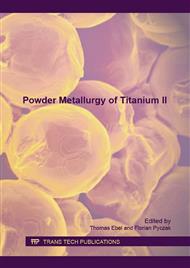[1]
R. O. Ritchie, in: ASM Intl. Materials and Processes for Medical Devices Conference, St., Paul, Minnesota, (2004).
Google Scholar
[2]
E. W. Collins, The physical Metallurgy of Titanium Alloys, in: ASM Metal Processing, Ohio, (1984).
Google Scholar
[3]
J. Currey, Cortical bone, in: Handbook of Biomaterial Properties, J. Black and G. Hastings (Ed. ), London: Springer – Verlag, 1998, p.629.
Google Scholar
[4]
L. L. Hench, J. R. Jones, Biomaterials, Artificial Organs and Tissue Engineering, in: Cambridge, England: Woodhead Pub. Ltd, (2005).
Google Scholar
[5]
H. Zhang, M. Ahmad, G. Gronowicz, Effects of transforming growth factor-beta 1 (TGF-beta1) on in vitro mineralization of human osteoblasts on implant materials, Biomaterials. 24 (2003) 2013-(2020).
DOI: 10.1016/s0142-9612(02)00616-6
Google Scholar
[6]
E. Eisenbarth, J. Meyle, W. Nachtigall, J. Breme, Influence of the surface structure of titanium materials on the adhesion of fibroblasts, Biomaterials. 17 (1996) 1399-1403.
DOI: 10.1016/0142-9612(96)87281-4
Google Scholar
[7]
C. Aparicio, Tratamientos de superficie sobre titanio comercialmente puro para la mejora de la osteointegración de los implantes dentales, Universidad Politécnica de Barcelona, (2005).
DOI: 10.3989/revmetalm.1998.v34.iextra.735
Google Scholar
[8]
J. Lausmaa, Mechanical, thermal, chemical and electrochemical surface tretament of titanium, In: Titanium in Medicine, Brunette, D.M., Tengvall, P., Textor, M. and Thomsen, P., (Ed. ), 231-266, Springer-Verlag, Berlin, (2001).
DOI: 10.1007/978-3-642-56486-4_8
Google Scholar
[9]
J. Pavón, P. Velásquez, S. Velásquez, in: 22nd European Conference on Biomaterials, 07-11th September, 2009, Lausanne, CH.
Google Scholar
[10]
X, Zhu, J. Chen, L. Scheideler, R. Reich, J. Geis-Gerstorfer, Effects of topography and composition of titanium surface oxides on osteoblast responses, Biomaterials. 25 (2004) 4087-4103.
DOI: 10.1016/j.biomaterials.2003.11.011
Google Scholar
[11]
L. L. Hench, S. Best, Ceramics, Glasses and Glass- Ceramics, in: P.D. Ratner, A.S. Hoffman, F.J. Schoen, J. E. Lemons (Eds. ), Biomaterials Science: An Introduction to Materials in Medicine, Elsevier Academic Press, California, 2004. p.154.
Google Scholar
[12]
T. Kokubo, F. Miyaji, H. M. Kim, T. Nakamura, Spontaneous formation of bonelike apatite layer on chemically treated titanium metals, Journal of the American Ceramic Society, 79 (1996) 1127-1129.
DOI: 10.1111/j.1151-2916.1996.tb08561.x
Google Scholar
[13]
A. Abarrategui, Estudio del quitosano como biomaterial portador de rhBMP-2: desarrollo, caracterización y aplicabilidad en regeneración de tejido óseo, Tesis Doctoral, Universidad Complutense de Madrid, (2008).
DOI: 10.35537/10915/2769
Google Scholar
[14]
B. Ziberi, F. Frost, Th. Höche, B. Rauschenbach, Ripple pattern formation on silicon surfaces by low-energy ion-beam erosion: Experiment and theory, Physical Review B, 72 (2005) 235-310.
DOI: 10.1103/physrevb.72.235310
Google Scholar
[15]
Y. Torres, S. Lascano, J. Bris, J.J. Pavón, J.A. Rodríguez, Development of porous titanium for biomedical applications: a comparison between loose sintering and space holder techniques, Materials Science and Engineering C, 37 (2014) 148–155.
DOI: 10.1016/j.msec.2013.11.036
Google Scholar
[16]
L. Byounggab, L. Taekyung, L. Yongmoon, J.L. Dong, J. Jiwon, Y. Junhan, H.O. Sang, S.K. Hyoung, S.L. Chong, Space-holder effect on designing pore structure and determining mechanical properties in porous titanium, Materials and Design, 57 (2014).
Google Scholar
[17]
D.S. Li, Y.P. Zhang, X. Ma, X.P. Zhang, Space-holder engineered porous NiTi shape memory alloys with improved pore characteristics and mechanical properties, Journal of Alloys and Compounds, 474 (2009) L1-L5.
DOI: 10.1016/j.jallcom.2008.06.043
Google Scholar
[18]
Y. Torres, J.A. Rodriguez, S. Arias, M. Echeverry, S. Robledo, V. Amigo, J.J. Pavon, Processing, characterization and biological testing of porous titanium obtained by space-holder technique, Journal of Materials Science, 47 (2012) 6565-6576.
DOI: 10.1007/s10853-012-6586-9
Google Scholar
[19]
Y. Torres, J.J. Pavon, J.A. Rodriguez, Processing and characterization of porous titanium for implants by using NaCl as space holder, Journal of Materials Processing Technology, 212 (2012) 1061-1069.
DOI: 10.1016/j.jmatprotec.2011.12.015
Google Scholar
[20]
B. Vamsi Krishna, W. Xue, S. Bose, A. Bandyopadhyay, Functionally graded Co–Cr–Mo coating on Ti–6Al–4V alloy structures, Acta Biomaterialia, 4 (2008) 697-706.
DOI: 10.1016/j.actbio.2007.10.005
Google Scholar
[21]
T. Traini, C. Mangano, R.L. Sammons, F. Mangano, A. Macchi, A. Piattelli, Direct laser metal sintering as a new approach to fabrication of an isoelastic functionally graded material for manufacture of porous titanium dental implants, Dental Materials, 24 (2008).
DOI: 10.1016/j.dental.2008.03.029
Google Scholar
[22]
B. Vrancken, L. Thijs, J.P. Kruth, J.V. Humbeeck, Heat treatment of Ti6Al4V produced by Selective Laser Melting: Microstructure and mechanical properties, Journal of Alloys and Compounds, 541 (2012) 177–185.
DOI: 10.1016/j.jallcom.2012.07.022
Google Scholar
[23]
B. Vrancken, L. Thijs, J. -P. Kruth, J. Van Humbeeck, Microstructure and mechanical properties of a novel β titanium metallic composite by Selective Laser Melting, Acta Materialia, 68 (2014) 150-158.
DOI: 10.1016/j.actamat.2014.01.018
Google Scholar
[24]
B. Otsuki, M. Takemoto, S. Fujibayashi, M. Neo, T. Kokubo, T. Nakamura, Pore throat size and connectivity determine bone and tissue ingrowth into porous implants: Three-dimensional micro-CT based structural analyses of porous bioactive titanium implants, Biomaterials, 27 (2006).
DOI: 10.1016/j.biomaterials.2006.08.013
Google Scholar
[25]
M. Takemoto, S. Fujibayashi, M. Neo, K. So, N. Akiyama, T. Matsushita, T. Kokubo, T. Nakamura, A porous bioactive titanium implant for spinal interbody fusion: an experimental study using a canine model, J Neurosurgery: Spine, 7 (2007) 435-443.
DOI: 10.3171/spi-07/10/435
Google Scholar
[26]
ASTM E384-05a (2005) Standard Test Method for Microindentation Hardness of Materials, West Conshohocken, PA.
Google Scholar
[27]
ASTM C1624-05(2015), Standard Test Method for Adhesion Strength and Mechanical Failure Modes of Ceramic Coatings by Quantitative Single Point Scratch Testing, (2015) ASTM International.
DOI: 10.1520/c1624-05
Google Scholar
[28]
D. Velten, V. Biehl, F. Aubertin, B. Valeske, W. Possart, J. Breme, Preparation of TiO2 layers on cp-Ti and Ti6Al4V by thermal and anodic oxidation and by sol-gel coating techniques and their characterization, Journal of Biomedical Materials Research, 59 (2002).
DOI: 10.1002/jbm.1212
Google Scholar


